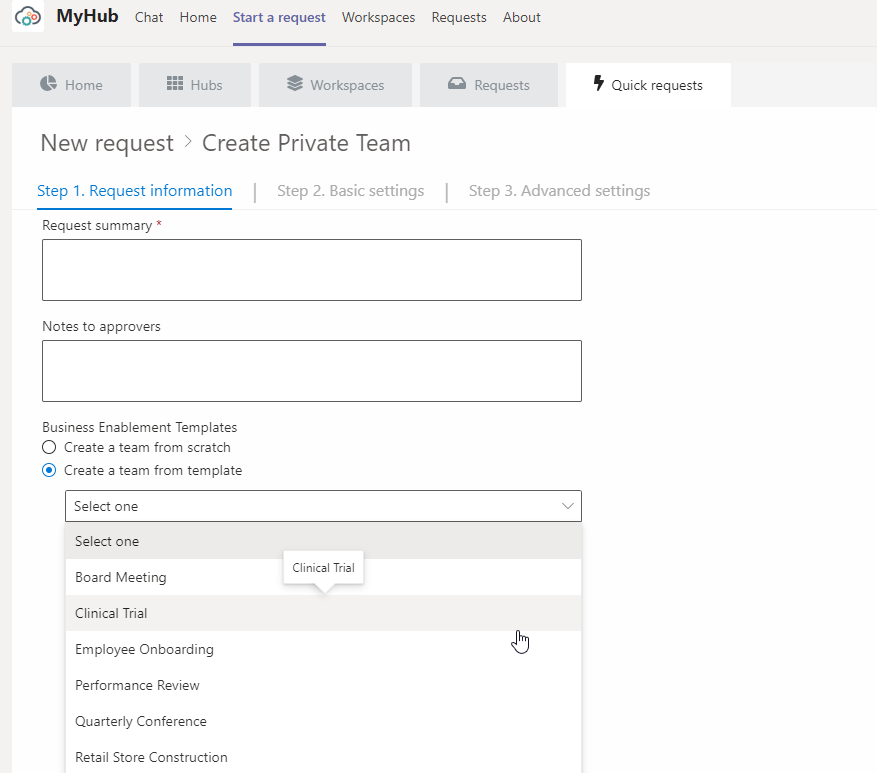Microsoft Teams Templates vs. Team Cloning: Which Approach is Best?


Looking for Teams management tips while WFH? Watch our free webinar “7 Tips to Improve Remote Work and Ditch Content Sprawl with Microsoft Teams” today!
Microsoft’s recent announcements around Microsoft Teams governance at Microsoft Build 2020 generated quite a bit of buzz—and for good reason. They laid out a slew of compelling new provisioning features to help customers better manage their information in Teams. For those new to the platform, however, the benefits and complications of something like Teams templates might be a bit unclear.
Microsoft has two ways to create a Team that has a pre-defined structure with Channels, Tabs and so on: you can clone a Team or you can use a Team template. No matter which method you use, the end result is a pre-configured Team that’s ready-made for a specific business purpose. Let’s dive into the pros and cons of each.

Microsoft Teams Templates
Largely created for the industry-specific work that Microsoft has been investing in for Teams, Microsoft built the concepts of a “template” as the starting point for a Team. There were originally only six of these base template types and there was no way to create your own or modify the existing ones. You could only invoke these base templates if a) your tenant was set up for one of the supported template industries (Education, Healthcare or Retail) or b) you built your own application or process to call the Teams API and invoke one of the templates when creating a Team.
(Side note: Did you know that the basic Team layout we’re all familiar with—General channel only with Conversations, Files and Wiki Tabs—is actually the simplest base template type, called “Standard?” We’ve all been using Teams Templates even without knowing it!).
Looking for more background on last month's Teams templates announcements? Check out this post: Click To TweetBecause this functionality didn’t allow you to create your own templates or modify existing ones, the only way you could build your own was to create an application that starts with a base template and layers on additional components (Channels/Tabs/Apps/Connectors etc.) by a series of API calls to generate these additional configurations. Obviously, this approach had some downsides:
- It took a skilled programmer to create these configurations.
- If any change was needed to the template, it required a programmer to go in and edit the configurations.
- There was no way to simply take an existing Team and capture a “template” based on it.

Cloning a Team
“Cloning” a Team has been a much simpler way to get to a similar result as following a template. With this method, you simply tell Teams (through the normal Teams provisioning process or via APIs) that you want your new Team to be based off an already existing Team. This allows you to take as much as you want from the source Team (Channels, Tabs, Members, Settings, etc.) and incorporate that into your new Team. This approach is much simpler than the Teams Template approach because:
- Anyone can do it. If you can build a Team, and you have the Office 365 permission to create a new Team, you can choose to clone an existing one. And this opens up scenarios such as departments building their own best practice “reference” Teams and using them as the source for new Teams with similar business purposes.
- It’s very easy to change your “template.” Just go to the reference Team, make your modification, and now all new Teams you clone will have the new configuration.
- “Capturing” a Team as a template was unnecessary since all that mattered was that the Team existed.
At AvePoint, we’ve leveraged the “clone” approach as part of our Cloud Governance solution for years now. This lets organizations configure best-practice Teams for various purposes. Then by assessing a user’s business purpose, we can present the requestor with a curated set of ready-made “templates” to get their work done. This approach has made templates easier to create and modify than ever. We’ve also been able to give IT admins control over who sees and has access to certain templates.

How We’re Helping
Microsoft recently announced several improvements to Microsoft templates. Features like templates catalogues, template capture from existing Teams, and template-driven provisioning will be coming in a free update to Teams in the near future. Once these release no one will need to use the clone method to provide curated, pre-configured Teams going forward.
As a trusted partner we applaud Microsoft for increasing the value of their out-of-the-box offering for Teams templates, and plan to add value to it by offering various enhancements and integrations. These will include things like:
- Allowing admins to offer specific and relevant templates to users based on their role, purpose or division
- Making templates a criteria in which policies, metadata and controls are applied by Cloud Governance during the auto-import process
- Allowing self-service capabilities for departmental users to request that one of their existing Teams be captured as a template and made available to appropriate users (thus cutting down on admin strain)

These are just a few of the ways we plan to continue working side-by-side with Microsoft to offer the most comprehensive Microsoft Teams governance tools out there. Have any questions? Feel free to leave suggestions in the comments below!
Looking for more on Microsoft Teams? Be sure to subscribe to our blog.

John Peluso is AvePoint’s Chief Technology Officer. In this role, he aligns the Company’s technology and product roadmaps to grow AvePoint’s market share, and accelerate the ideation, development, and launch of innovative software products tailored to anticipate customer needs. Prior to this role, John held multiple leadership roles over his 13-year tenure at AvePoint, including Chief Product Officer, SVP of Product Strategy, Director of Education, and Chief Technology Officer, Public Sector.
Before joining AvePoint, John served in a variety of technology and business roles at New Horizons Northeast and New Horizons of Central and Northern NJ. He earned his undergraduate degree from The New School.


